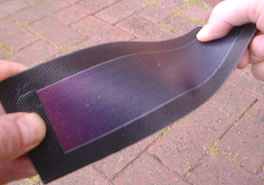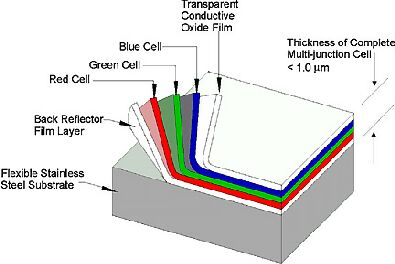|
UNI-SOLAR - THIN FILM TECHNOLOGY |
||
|
HOME SITE INDEX CATAMARAN HULL SOLAR PANELS ELECTRIC MOTORS BATTERIES CREW EXPEDITION SPONSORS GOODIES |
||
|
Crystalline
silicon was the original materials technology used by the PV industry
to manufacture solar cells. First widely used in space
satellites, conventional crystalline silicon solar cells are
fabricated in a step-and-repeat, batch process from small wafers of
single crystal or polycrystalline silicon semiconductor
materials. Although, substantial advances have been made in the
development of this technology, the cost of crystalline PV modules is
still high because of materials costs and numerous processing steps
that are needed to manufacture the modules. Crystalline silicon solar
modules are bulky, break easily, and consume more energy in
manufacturing.
Tandem Junction Cells
Thin-film amorphous silicon, 175mm x 60mm (less than 1mm thick) Output 330mA and 1.2V (stable), a usable current/voltage characteristic, open circuit 2V in full sunlight Flexible, virtually unbreakable Light-weight (19g with pinch terminals), waterproof, high power/weight ratio Durable, 20year useful life applicable to all climates because it also responds to light scattered by cloud cover (please note these cells are discontinued)
Triple Junction Cell Specifications (1-Q laminate):
Thin-film amorphous silicon, 190mm x 57mm (1mm thick) Output 330mA and 1.5V (stable) Flexible, virtually unbreakable Light-weight (23g with pinch terminals) Waterproof, high power/weight ratio Durable, 20year useful life responds to diffuse light scattered by cloud cover You can purchase the above cells from Wholesale price list >> Plugging Into The Sun The above flexible solar cells are based on a sophisticated multi-layer amorphous silicon thin-film solar cell developed originally by Energy Conversion Devices, Inc, USA. This spectrum-splitting cell, shown schematically below, is constructed of separate p-i-n type, amorphous semiconductor solar sub-cells, each with a different spectral response characteristic. This allows the cell to convert the different visible and near infrared wavelengths of sunlight with optimal efficiency. This spectrum-splitting multijunction design now holds all the world's records for amorphous silicon solar cell efficiency, including the highest stable efficiency measured by the National Renewable Energy Laboratory (NREL) for a small-area amorphous silicon solar cell @ 13 percent.
DEVELOPMENT HISTORY:
Uni-Solar have an annual production capacity of 5MW that is now being expanded to 30MW by the addition of a new facility located in Auburn Hills, MI. This plant is fully automated and allows simultaneous processing of six rolls of stainless steel, each 1 1/2 miles long, during deposition of the a-Si layers. The thin-film materials, cell designs, and manufacturing processes used by United Solar Systems Corp. are protected by more than 160 issued U.S. patents.
Find out more from: United Solar Systems Corp. CONTACT: nelson@solarnavigator.com 07905 147709 (UK)
|
||
|


